Pine buds
Pine buds and their benefits
🌲 Pine buds are a valuable herbal remedy, recognized for their anti-inflammatory, expectorant and immunostimulant effects. Ideal for colds, coughs, respiratory infections and fatigue, they help strengthen the immune system and vitalize the whole body.
Pine belongs to the Pinaceae family, and is a plant native to the Nordic countries. Although it resembles the fir tree, the pine tree produces more resin and has several therapeutic properties.
Pine buds are the youngest parts of the pine tree and can be seen at the end of pine branches. They have a light green color that is different from the rest of the tree and develop in spring. The harvesting period can start in April or the first half of May and can even extend into June for mountain areas.
They are harvested when the buds are at least 2-3 cm but no larger than 7 cm and it is advisable to choose unpolluted areas for harvesting.
Buds are an edible part of the pine tree and are found on at least 20 species of the tree. Among the popular varieties of pine from which buds can be harvested are Italian pine (Pinus pinea), Mexican pine (Pinus cembroides), Colorado pine (Pinus edulis) and Chinese pine (Pinus koraiensis).
Another part that can be consumed is the pine cone. Pine-cone tincture is a preparation that prevents cardiovascular disease, balances blood pressure and helps speed up the recovery of stroke patients.
🧪 The nutritional profile of pine buds
Pine buds have a host of beneficial effects and are a rich source of vitamins, minerals, antioxidants, essential oils and unsaturated fatty acids. They contain vitamins E, B1, B2, B3, B9, calcium, iron, phosphorus, copper, manganese, antioxidants, minerals, unsaturated fatty acids (alpha-linoleic acid, oleic acid, pinoleic acid, Omega 9), beta-carotene, lutein, zeaxanthin, essential oils, bitter substances.
Nutritional values per 100 grams of pine buds:
Nutritional values
Calories: 673Protein: 10g
Fiber: 10g
Mineral
Zinc: 6.45mgPhosphorus: 575mg
Magnesium: 251mg
Manganese: 8,802mg
Iron: 5,53mg
Copper: 1,324mg
Calcium: 16mg
Vitamins
Vitamin E: 9,33mgVitamin C: 0,8mg
Vitamin A: 29 IU
💚 Benefits of pine buds
The phytotherapeutic actions of pine buds underpin many treatments.
They are known to cure colds, respiratory ailments, whooping cough and decongest the airways.
Buds act as a calming agent, making them a good remedy against migraines, asthenia or anemia. They also maintain the health of the osteo-articular system and act as a remineralizer and joint regenerator, as well as a good treatment for rheumatism. The main benefits are:
Pine buds are recognized for their beneficial effects:- antiseptic
- expectorant
- anti-inflammatory
- anti-rheumatic
- soothing
- antispaspaspas
- decongestant
- healing
- astringent
- vitaminizing
- sedative
- diuretic
- anti-diarrhea
Maintain respiratory health
Pine buds used in syrups or macerates can help treat various respiratory conditions such as cough, hoarseness, laryngitis, pharyngitis, bronchitis.
Improves vision
Pine buds contain zeaxanthin and lutein, which help the eye filter ultraviolet rays, delay macula damage and reduce the risk of cataracts. The beta-carotene content in the buds is converted by the body into vitamin A, a nutrient that is beneficial for maintaining retinal health.
Have energizing effect
Pine buds are rich in protein which provides the body with increased energy levels and helps fight fatigue. The iron contained in the buds helps cells to produce and store the energy needed by the human body.
Improve heart health
The fiber, mineral and antioxidant content helps keep the heart healthy. Eating pine buds helps reduce the risk of cardiovascular problems.
Prevent premature ageing
The antioxidants and copper found in pine buds prevent the negative effects of free radicals, which cause the body to age. Antioxidants also help make the body more resistant to viruses.
Reduce the risk of cancer
Antioxidants in pine buds fight cancer-fighting free radicals.
Helps weight loss
Pine buds contain linoleic acid, which stimulates the production of the hormone CCK (the satiety hormone), responsible for stopping the feeling of hunger. Regular consumption of buds helps to lose extra pounds.
Fights fatigue
Buds contain iron, the main constituent of hemoglobin, which is responsible for transporting oxygen in the body. An adequate supply of iron in the body helps fight fatigue and restore energy.
⚠️ Contraindications
Pine preparations have no adverse effects if taken as directed by a doctor experienced in apiphytotherapy. But caution is advised in pregnant women, children and people with chronic diseases.
🍳 How are pine buds used?
Pine buds can be consumed or used in different ways depending on the conditions we want to treat. Since ancient times, pine has been used to make syrups, teas or extracts. For better health, you can try:
- Pine bud syrup
- Chewing raw pine buds
- Macerate
- Infusion
- Inhalation
- Decoction
- Pine bud extract (Gemoderivative)
- Essential oil
- Pine bud poultices
🧴 Pine bud preparations and their benefits:
Pine bud syrup
- maintains respiratory health
- helps decongest the respiratory tract and treat irritation
- effective in treating whooping cough
- normalizes bronchial secretions
- cold remedy
- to relieve unpleasant symptoms drink one teaspoon of syrup 3 times a day between meals
- is used to treat migraine headaches (take 2 teaspoons of syrup in the morning on an empty stomach, at least 3-4 consecutive days)
Raw pine buds
- promote cardiovascular health
- can be used in slimming cures as they regulate appetite and reduce the amount of food the body needs; chew 2-3 pine buds a quarter of an hour before a meal
Macerate pine buds in honey
- used for respiratory ailments, cough, hoarseness, laryngitis, pharyngitis, bronchitis
- useful in nervous exhaustion, anemia, asthenia
Infusion
- used as an expectorant remedy
- the tea has anti-inflammatory and antiseptic properties of the urinary and respiratory tracts
Inhalation
For sinusitis, a 10-minute inhalation may be taken.
Decoction
- can be used for skin inflammations as a disinfectant and skin soother
- can be used for gargling
- for cosmetic purposes, the decoction is used in the bath to purify the skin, stimulate and tone the body
- can be used to eliminate unpleasant odors
Essential oil
- has antiseptic, antimicrobial and anti-inflammatory action
- has antioxidant effects
- fluidizes bronchial secretions
- acts as an expectorant and is used to treat coughs
- recommended in respiratory diseases accompanied by cough (laryngitis, tracheitis, bronchitis)
- recommended for urinary disorders (cystitis, urethritis, pyelitis)
- nasal decongestant
- treats dermatological conditions (pimples, eczema, psoriasis, insect bites)
- is a good analgesic, relieves joint and rheumatic pains
- speeds up metabolism and helps treat intestinal problems
Pine bud extract
- has a beneficial action on the osteo-articular system
- regenerates bone and cartilage tissue and assists in their rebuilding process
- helps strengthen fractures due to its remineralizing effect
- helps regenerate joints and improve their mobility
- used for conditions such as coxarthrosis, gonarthrosis, osteoporosis, chronic degenerative rheumatism, fractures, vertebral arthrosis
Pine oil
- is used for skin care and to treat various problems (wounds, psoriasis, eczema, pimples, itching, skin diseases)
- acts as an antioxidant against free radicals
- helps relieve mental stress relieves anxiety and nervous tension
Pine bud poultices
For rheumatic or joint pain, you can use the buds as a poultice
Pine bud tincture
Take one teaspoon of tincture diluted in a quarter of a glass of water 3-4 times a day;
Internal use:
- it is used for cough, neuralgia, pulmonary diseases, bronchitis, cystitis, cystitis, pyelitis, urethritis, periarthritis
- also used as a mouth, nose and pharynx disinfectant
External use:
- used for neurosis, cardiac neurosis
- used for wound healing
- helps soothe red and irritated skin
🤔 Did you know...? Fun facts about pine buds
Much of the products of the pine tree are used to prepare health-promoting cures. Besides buds and cones, pine needles, resin and bark can also be used.
- 🍋 Pine buds are rich in vitamin C, strengthening the immune system.
- 🌬️ They have expectorant, antimicrobial and anti-inflammatory effects, helping to decongest the airways.
- 🤧 They are used to treat persistent coughs and bronchitis due to their antiseptic properties.
- 🫁 Contain volatile oils with benefits for the respiratory system.
- 🤒 Pine bud infusion relieves cold symptoms such as fever and muscle aches.
- 🩸 Pine bud syrup is tonic, useful in anemia and fatigue.
- 🕯️ Pine essential oil is used in aromatherapy, for relaxation and clearing the airways.
- 🚰 They have a diuretic effect, favoring the elimination of toxins.
- 🦵 Use externally for joint pain, due to the anti-inflammatory effect.
- 🛡️ Contain antioxidants, which protect cells from oxidative stress.
- 🦠 Natural antiseptic properties, useful in treating skin infections.
- 🍽️ Improve digestion, soothe cramps and reduce bloating.
- 🏋️ Contain essential minerals such as iron, magnesium and zinc.
- 🍹 Used in natural drinks for flavor and freshness.
- 🩹 Traditional remedy in rheumatism for its anti-inflammatory action.
- 🥖 Add to bread or biscuits, for extra flavor and benefits.
- 🎤 Infusion helps with laryngitis, soothing irritated throat.
- 🤢 Recommended for upset stomach due to the soothing effect.
- 💆♀️ Use in cosmetic treatments, for skin regeneration.
Summary
Beneficial effects:
- Anti-inflammatory
- Anti-rheumatic
- Antibacterial
- Expectorant
- Decongestants
- Antiseptic
- Antispaspaspas
- Astringent
- Sedative
- Balsamic
- Healing
- Antioxidant
- Vitaminizing
- Immunostimulating
- Tonic
- Diuretics
- Energizing
- Digestive
- Anti diarrhea
Side effects:
- Mild nausea with excessive consumption
- Gastric discomfort in sensitive individuals
- Skin rash in rare cases of intolerance
Contraindications:
- Contraindicated for pregnant women without medical advice
- Avoid use in children under 2 years of age
- Not recommended if allergic to conifers
- Avoid in case of acute gastritis
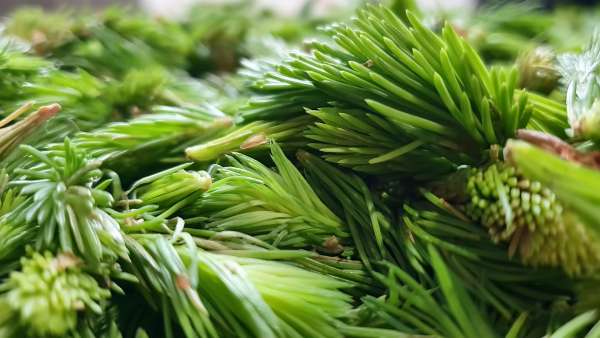
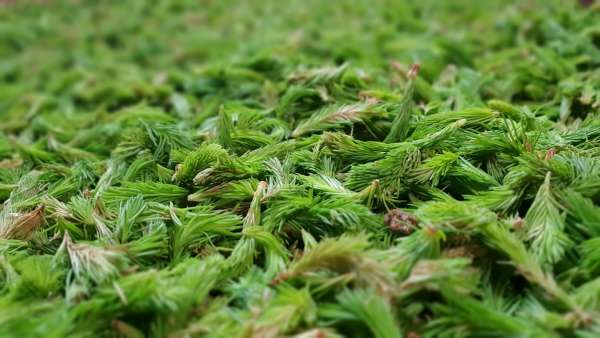
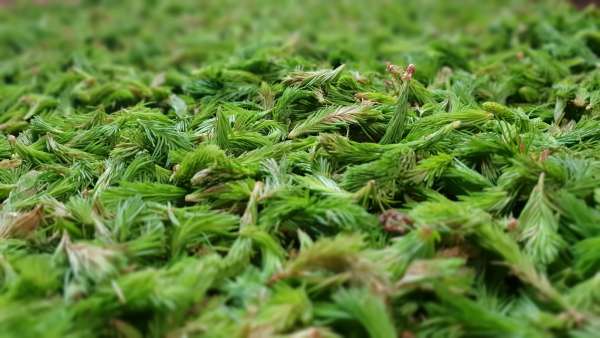
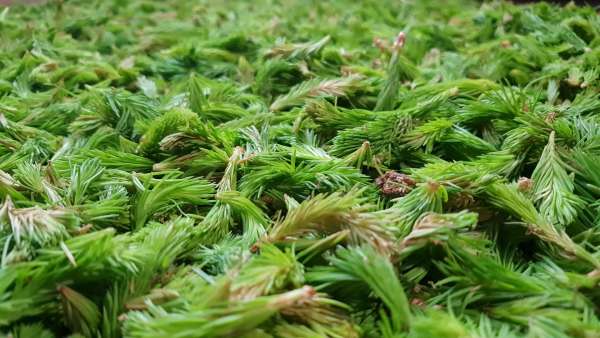
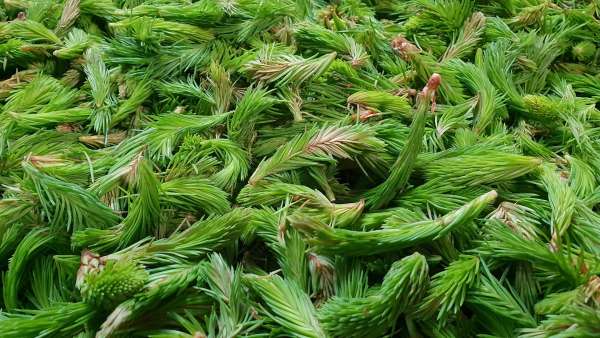


Comments